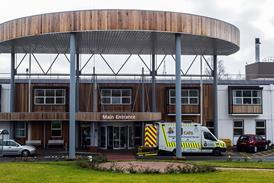NHS England’s primary care estates review aims to break down system barriers preventing the development of modern, fit for purpose healthcare buildings. But will its solutions ultimately see government, investors and primary care professionals equally embracing a bold new future? By Finn O’Dwyer
Last week, NHS England’s “Call for Solutions” for the primary care estate came to a close, following a month of engagement with stakeholders across the sector.
It’s fair to say the discussion prompted by the review is welcome. NHS England should be credited for pursuing targeted and forward looking engagement with the sector which genuinely seeks practical solutions to the issues preventing progress.
There’s also no doubt such a review was overdue. The independent Naylor review of NHS property and estates, published last March, called for investment in the primary care estate as an urgent priority to support the development of new care models.
The government has come forward with a £3.5bn capital commitment to support improvements to the healthcare estate, alongside a promise to harness a further £3bn both from private sector investment, and from surplus land receipts.
But this impressive capital injection will fail to make an impact if enthusiasm for new development is not shared across the country, and current barriers preventing estates improvement are not overcome.
Lack of action and an ongoing impasse
At the risk of oversimplifying, the current review is broadly a response to a major strategic policy shift – the government’s acknowledgement of estates as a key “enabler” for the transformation of health and social care following a lack of recent development – and one persistent and difficult problem: the “last man standing” issue for GPs.
Earlier this year, negotiations over the 2018-19 GP contract were held up by this issue, upon which NHS England and the British Medical Association’s general practitioners’ committee have long been at loggerheads.
The key regulations surrounding GP rent reimbursement – the Premises Cost Directions – are as outdated as many of the buildings to which they apply, but the release of an updated version has been blocked by disagreements over the right solution to this issue as well.
GPs are understandably concerned that the workforce recruitment crisis; the anticipated proliferation of multidisciplinary “hubs” models within primary care; and the decreasing desirability of direct premises ownership will leave a “last partner standing” in older surgeries across the country, piling unmanageable liabilities onto tenured GPs working towards retirement.
The review was partially set up to find a solution to this tricky barrier, but it also needs to suggest ways to incentivise strategic estates development while optimising utilisation of existing facilities at a local level; reducing concerns over the signing of long term leases; and providing more clarity over arrangements for cost reimbursements.
Solutions on the table?
The Department of Health and Social Care and NHS England have in recent weeks been particularly eager to sit around the table with GPs, investors and other stakeholders in the sector to hear their proposed solutions to these issues.
The task for NHS England now is to harness ideas from across the sector, and finally find the way to break down the barriers to progress
One absolute necessity for the system is the creation of more closely conjoined clinical service and estates strategies. While officials at sustainability and transformation partnership, integrated care system and local level are being asked to develop plans ensuring integrated delivery through new care models, the approaches within specific areas often differ significantly.
For example, buildings designed to house a multitude of primary and community services are often occupied by providers on leases of vastly different lengths of time, leading to poor levels of utilisation once the clinical service contracts of shorter term tenants have run their course.
To solve this, long term leases could be underwritten by STPs or arms length bodies, allowing individual providers to come and go. This would provide more flexibility for commissioners to base service contracts on the changing needs of local patients, while ensuring continuously strong levels of utilisation within high quality buildings.
Second, estates investors need to be offered encouragement that there is real enthusiasm for premises improvement and development at all levels within the NHS, not to mention the ongoing financial headroom to pay the rent. Government could look at reforming the GP reimbursement system to provide ongoing support for all costs related to premises ownership and occupation.
Both of these approaches would provide some long term reassurance to mitigate the “last man standing” issue.
What is clear is that private investors are willing and able to commit the capital to help deliver the government’s healthcare infrastructure transformation. This week, the LIFT Council has launched a research report detailing LIFT companies’ role in developing over 350 NHS buildings over the past 15 years, and its offer to aid the creation of a primary care estate fit to deliver effective, integrated care in the community for patients.
The will is undoubtedly there amongst all stakeholders engaged with the “Call for Solutions” review. The task for NHS England now is to harness ideas from across the sector, and finally find the way to break down the barriers to progress.





























No comments yet